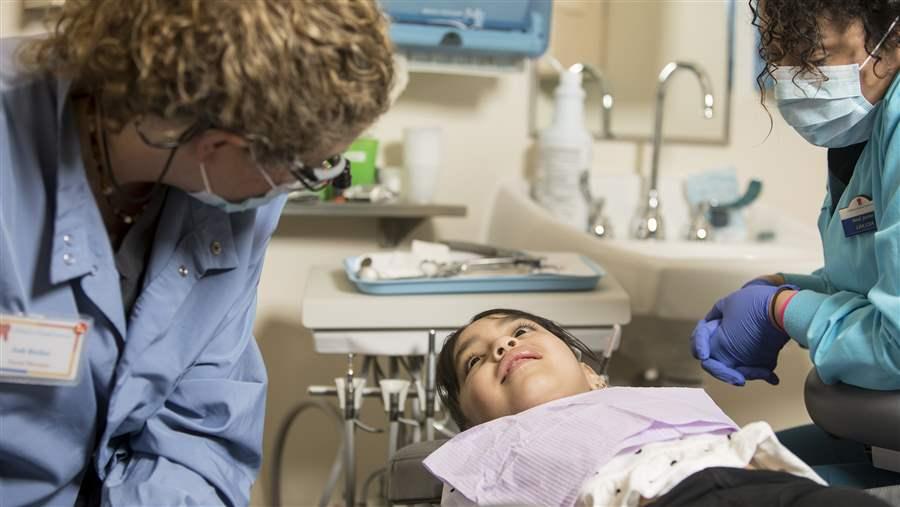In Minnesota, a Dental Therapist Helps Kids Get the Care They Need
Flexible schedules and mobile equipment reach vulnerable communities

Jodi Becker, a dental therapist with Children's Dental Services performs dental treatments on Citlali Perez at their mobile clinic in Richfield, Minn., on April 20, 2017.
© Ackerman+Gruber/The Pew Charitable Trusts
When the 8-year-old girl sat down under the bright lights in Jodi Becker’s dental chair, she clearly needed help. She had a toothache, and from the way her eyes darted around the temporary examining room in a high school, she also seemed nervous. She had never seen a dentist. But Becker, an advanced dental therapist, knows how to calm kids who are saying “Ah” for the first time and how to help parents understand why care is needed. She uses soothing words and a calm demeanor. Soon, Becker extracted four of the girl’s teeth and sent her patient home with a dental kit and lessons on how to use it.
This is what Becker loves about the field of dental therapy. “The best part of my job is treating kids who might not otherwise receive care,” she says. “When a child has a toothache, they may miss school or find it hard to concentrate. Plus, if the tooth is not treated, it can cause serious side effects.”
Many Minnesota children are now receiving care because their state allows dentists to hire dental therapists like Becker. These professionals—midlevel providers akin to physician assistants—provide routine prevention and treatment services, such as filling cavities and placing temporary crowns. They work in a range of settings—public clinics, community health centers, private practices, and sometimes nursing homes and schools—to reach populations that face challenges traveling to an office. Advanced dental therapists can also make a diagnosis and create a treatment plan as well as provide follow-up care.
Becker and her dental assistant began a fully booked day recently by loading their van with an array of sterilized and packaged dental tools, drill bits, mirrors, X-ray equipment, a chair, and other necessities for a pop-up dental office at Richfield High School in Richfield, a Twin Cities suburb. Both work for Minneapolis-based Children’s Dental Services (CDS), a nonprofit organization that serves patients to age 26 as well as pregnant women, and treated 35,000 people in 2016. The organization accepts all forms of public and commercial insurance, and offers a sliding scale for those who fall below the federal poverty level. CDS is the largest provider of on-site dental care in Minnesota schools and Head Start centers.
By using dental therapists, states are providing a basic health service for vulnerable communities. While Minnesota was the first state to authorize the dental therapy profession eight years ago, similar providers have worked with tribal communities in Alaska since 2004 and practice in more than 50 countries. Maine and Vermont changed their laws to allow dentists to hire dental therapists; Arizona, Maryland, Massachusetts, Michigan, and New Mexico are among many states considering new laws.
That day in Richfield, parents expressed gratitude that their children could get help. “They will see my kids when no one else will, even though I don’t have insurance,” said one guardian. And dental therapists such as Becker can offer flexibility that an office-bound dentist can’t, according to a parent: “If I can’t make it in the morning, they will work with me.”
Becker also can connect with a CDS dentist, should she need to, through tele-dentistry to view digital X-rays and electronic charts. But she can largely handle her cases independently. “Dental therapists are a great tool,” Becker says. “We have kids who don’t have to go to an emergency room for a toothache anymore.”
A few months earlier, Becker had traveled to Redwood Falls, about two hours southwest of the Twin Cities, for two days of appointments. The youngest child, age 3, from a family of seven came in after having been sent home from day care because of a toothache. Her sisters said she cried every night. “Everyone in the house would be awake because she had this infected tooth. It impacted the entire family,” Becker says. “One day we did the exam. The next day we were able to take out the tooth.”
Sometime later, when Becker returned to Redwood Falls, she learned that her patient seemed much happier. “She doesn’t cry anymore,” a sister told Becker.
“By being able to get to these kids to provide care for them, I see firsthand that we’re making a difference for a lot of kids in Minnesota,” Becker says.
John Grant directs The Pew Charitable Trusts’ dental campaign.






